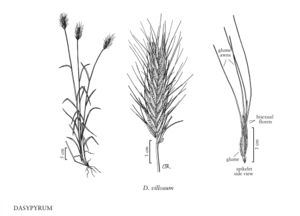Difference between revisions of "Dasypyrum villosum"
FNA>Volume Importer |
GeoffLevin (talk | contribs) m (Removed spurious character in authority) |
||
| (5 intermediate revisions by 2 users not shown) | |||
| Line 1: | Line 1: | ||
{{Treatment/ID | {{Treatment/ID | ||
|accepted_name=Dasypyrum villosum | |accepted_name=Dasypyrum villosum | ||
| − | |accepted_authority=(L.) P. Candargy | + | |accepted_authority=(L.) P. Candargy |
|publications= | |publications= | ||
|common_names=Mosquitograss | |common_names=Mosquitograss | ||
| Line 17: | Line 17: | ||
-->{{Treatment/Body | -->{{Treatment/Body | ||
|distribution=Pa. | |distribution=Pa. | ||
| − | |discussion=<p>Dasypyrum villosum is native from southern Europe to Turkey, the Crimea, and the Caucasus. The only known North American record is a collection made in Philadelphia County, Pennsylvania, in 1877.</p><!-- | + | |discussion=<p><i>Dasypyrum villosum</i> is native from southern Europe to Turkey, the Crimea, and the Caucasus. The only known North American record is a collection made in Philadelphia County, Pennsylvania, in 1877.</p><!-- |
| − | --><p>Dasypyrum breviaristatum (H. Lindb.) Fred, differs from D. villosum in being perennial and shortly rhizomatous, and in having stiff, dark green leaves, glume keels with hairs that are not in tufts, and awns to 15 mm long.</p> | + | --><p><i>Dasypyrum</i> breviaristatum (H. Lindb.) Fred, differs from <i>D. villosum</i> in being perennial and shortly rhizomatous, and in having stiff, dark green leaves, glume keels with hairs that are not in tufts, and awns to 15 mm long.</p> |
|tables= | |tables= | ||
|references= | |references= | ||
| Line 27: | Line 27: | ||
-->{{#Taxon: | -->{{#Taxon: | ||
name=Dasypyrum villosum | name=Dasypyrum villosum | ||
| − | + | |authority=(L.) P. Candargy | |
| − | |authority=(L.) P. Candargy | ||
|rank=species | |rank=species | ||
|parent rank=genus | |parent rank=genus | ||
| Line 35: | Line 34: | ||
|family=Poaceae | |family=Poaceae | ||
|illustrator=Cindy Roché | |illustrator=Cindy Roché | ||
| + | |illustration copyright=Utah State University | ||
|distribution=Pa. | |distribution=Pa. | ||
|reference=None | |reference=None | ||
| Line 40: | Line 40: | ||
|publication year= | |publication year= | ||
|special status= | |special status= | ||
| − | |source xml=https:// | + | |source xml=https://bitbucket.org/aafc-mbb/fna-data-curation/src/200273ad09963decb8fc72550212de541d86569d/coarse_grained_fna_xml/V24/V24_368.xml |
|subfamily=Poaceae subfam. Pooideae | |subfamily=Poaceae subfam. Pooideae | ||
|tribe=Poaceae tribe Triticeae | |tribe=Poaceae tribe Triticeae | ||
Latest revision as of 17:40, 1 December 2021
Plants annual. Culms 20-100 cm, decumbent to geniculate, glabrous. Blades 1-5 mm wide, supple, light green. Spikes 4-12 cm long, 0.6-2 cm wide. Spikelets 7-22 mm excluding the awns. Glumes 9-40 mm including the awns, with tufts of hair on the keels, hairs 1.5-3 mm, white; bisexual lemmas 10-13 mm, glabrous proximally, sparsely pilose distally, with a tuft of stiff hairs below the awns, awns 15-60 mm, straight; sterile lemmas smaller, awns 7-10 mm; paleas to 14 mm; anthers 3, 4-7 mm. 2n = 14.
Discussion
Dasypyrum villosum is native from southern Europe to Turkey, the Crimea, and the Caucasus. The only known North American record is a collection made in Philadelphia County, Pennsylvania, in 1877.
Dasypyrum breviaristatum (H. Lindb.) Fred, differs from D. villosum in being perennial and shortly rhizomatous, and in having stiff, dark green leaves, glume keels with hairs that are not in tufts, and awns to 15 mm long.
Selected References
None.
